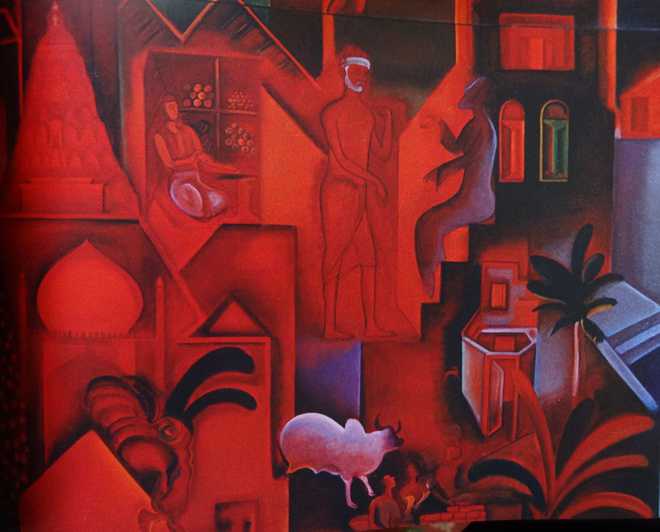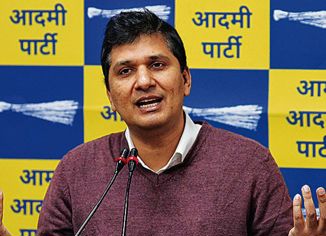
Detail from the mural, Tree of Life. 1996-97
BN Goswamy
Living in India means living in several cultures and times. — Gulam Mohammed Sheikh
The history of the great works of art tells us about their antecedents, their realisation in the age of the artist, their potential eternal after-life in succeeding generations…. — Walter Benjamin
I do not recall who, but some critic, writing, close to a hundred years ago, on the work of the great Russian painter Kandinsky spoke of “the tender violet-like amethysts of his snows at dawn, the emerald-like grass of his prairies, the pale turquoise of his northern skies, the mother-of-pearl of his clouds, the jasper and malachite of his rocks, the amber and rubies of his sunsets ….” This wonderful, moving evocation of colours has stayed with me for a long time, and it surfaces in my mind each time I see Gulam Sheikh’s work. For this eminent Baroda-based artist’s soul seems to remain drenched in colour, even as he takes the world on and treats of its pain and its anguish, its vismaya and its countless contradictions, in the remarkable range of his work.
Gulam has travelled a long distance in his life and undoubtedly he felt the touch, from time to time, of ‘the rough texture of the fingers on the hand of Time’ — dast-e lamhaat ki khurdari ungaliyan, as the poet put it — and yet he remains At Home in the World, as the title of the splendid new book on him, put together by Chaitanya Sambrani, says. There is so much here to read and to see in the work: the simple beginnings, marriage with the greatly gifted Nilima, extensive travels abroad, teaching at the MS University, emergence as a major figure in the world of contemporary art. When he paints, there is ‘irony, satire, purposeful forays into fantasy’, as Sambrani says; even occasional anger: but the extraordinary thing about Gulam’s work, at least as I see it, is the sense of calm that dwells in it. Dogs keep barking, gamblers keep gambling, lovers keep looking for furtive corners; crows caw, beggars move, houses tilt, trees strike root. But everything, and everyone, turns into a witness to the world that Gulam creates or trains his sights on. In between, every now and then, poetry surfaces and tends to take things over.
There is so much that one can write on Gulam’s body of work, but I do not have either the space here or the competence in general, to be able to do it. What I cannot do without, however, is drawing attention to the extent, and the manner, in which he looks at the past — not only the art of the past, but also the figures that wove their ways through its paths — and transforms it in his work: seeking ‘radically to reconfigure the world through inversion’, in a manner. Part of this comes from having studied and taught art history, but there is barely anyone else that one can think of who has internalised it, or engaged with it as intensely as he has. Let me take one example, just one, partially because there is room here only for one: ARK, a work that he made in more than one version. It features a large boat filled with figures and objects, drifting in a choppy, infested sea. Clearly it draws upon a wonderful painted sketch by the great 18th century painter, Nainsukh of Guler. Nainsukh’s work, which I reproduce here — mysterious in many ways, and challenging — is not easy to understand, or interpret. It shows his royal patron, Balwant Singh, a forlorn figure, seated in the stern, while the boat drifts downstream, teeming with hordes of men, palaces, elephants and horses, even a snow-clad mountain. What did the painter have in mind, one wonders?
WG Archer, writing in 1983, saw the sketch as ‘An Allegory of Disaster’, a ‘scene of hurried cataclysmic evacuation’. Something in the life of the prince must have happened, he speculated, and the work can ‘be construed as a study of him before and after this ruinous event’. With a fire raging on the further bank of the river, in ‘this sudden catastrophe, his former way of life was swept away as if by a raging torrent and of his palace built … on a rocky ridge, only memories, ruins and rocks remained’.
In my book on the painter Nainsukh, 1997, I saw the sketch differently. I titled it ‘A boat adrift on a river: Illustration to a folk legend” and wrote, referring to Archer’s description, that ‘poetic and silkily persuasive as this interpretation is, it poses problems’. Rather prosaically, I relied heavily on the inscriptions on the painting which provide a clue to our understanding. ‘The two men at the stern and the prow, according to the inscriptions, are musing about the foolishness of the man with the pole in the middle who, at this critical point, is more interested in marrying and learning the secrets of making the rasayan-potion from asannyasi than in saving the boat’. The dire strait of the boat, I added,‘is referred to again in the inscription at bottom left, a Persian saying being cited to say that in such a circumstance only disaster can lie ahead.’ To me it appeared ‘as if Nainsukh was availing himself of some local folk legend’ that centres on motifs of folly and destruction.
When Gulam painted ARK, he placed the figure of Gandhiji at the stern and that of Kabir at the prow. In between them, on the floor of the boat, were unconnected figures from diverse periods and styles whom one knows from Indian painting: the Khan Khanan Abdul Rahim, a Sufi saint sweeping the floor, a sadhu just back perhaps from a yatra, a kneeling courtier, etc. This brilliantly painted work, looking back over its shoulder while grounded in the present, can be seen differently. As referring to the 2002 Gujarat riots, which Sambrani does, for instance, ‘Sheikh’s covenant with the search for wisdom’, or, as distinguished academic Ananya Vajpeyi does: ‘as a dialogue between Kabir and Gandhi, signifying respectively, tradition and modernity, two powerful embodiments of radicalism and dissent in medieval and modern times.’
This then, the example I have taken, is quintessentially Gulam: while visually compelling attention, dipping into the past and nudging it into the present, throwing out ideas, posing questions, opening things up. There are not many that can do it.



























